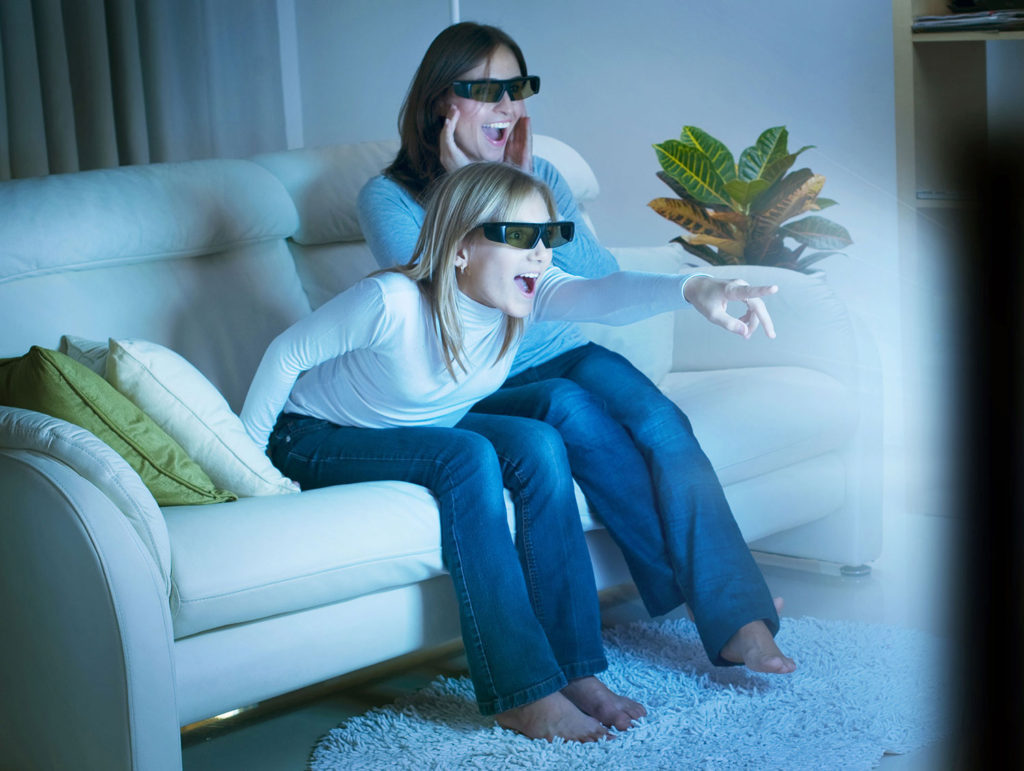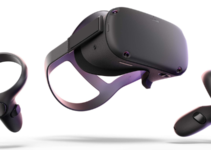IN A HURRY? CHECK OUT Sony TDG-BT500A Active 3D Glasses TOP PROS:
A set of 3D glasses is not just for watching a movie in a theater. There are 3D movies now available in Blu-ray and on streaming platforms such as Netflix, HBO GO, and Amazon. There are even quite a few game titles that support 3D that require 3D glasses to enjoy all the effects.
When it comes to the way they work, there are two types of 3D glasses: Stereoscopic and Polarized. Each have their pros and cons and each of them work on different screens. In this article, we’ll showcase the best 3D glasses on the market as well as guide you on how to pick the best pair for your 3D TV.
Even though watching 3D movies at home has fallen out of favor with TV manufacturers and (sadly) many consumers, there is still a small and loyal fan base. This niche group of avid 3D fans numbers in millions of sets in use around the world. The fan base is certainly big enough to motivate streaming services and publishers to release 3D titles.
CONTENTS:
- Before you buy: All you need to know about 3D glasses
- Top 4 Best 3D Glasses
- Active VS passive 3D television
- How we choose these products
| IMAGE | PRODUCT | DETAILS | |
|---|---|---|---|
 |
Our #1 Choice
Sony TDG-BT500A Active 3D Glasses |
|
Check on Amazon |
 |
Samsung SSG-5150GB |
|
Check on Amazon |
 |
Nvidia Vision 2 |
|
Check on Amazon |
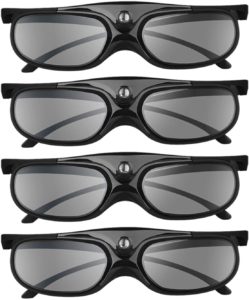 |
Boblov JX-30 DLP Link 3D Glasses |
|
Check on Amazon |
Before you Buy: All You Need to Know About 3D Glasses
3D glasses have come a long way since their inception. While most people think that 3D movies are invention of the 1970s you may be surprised that the first 3D movie was screened in 1922. Since then, 3D video technology has been in and out of mainstream every couple of years. The biggest advance in popularity of this technology was brought about thanks to James Cameron’s Avatar. Thanks to James Cameron, it looks like 3D technology is here to stay, with nearly every movie available in both regular and 3D flavors.
There’s a great chance that you’ve seen a 3D movie in a theater or you even watched 3D on your TV, but how do 3D glasses work? There are a few different types of these glasses that work in conjunction with projection to present you with an amazing visual display. Read on to learn more about it!
How do 3D Glasses Work?
3D glasses can be generally placed in three categories. These are anaglyph glasses, polarized glasses and shutter 3D glasses. Each pair uses a different method to make a flat image come to life on your screen.
Anaglyph 3D Glasses
Anaglyph 3D glasses are the most common type of 3D glasses and the iconic image many think about when they hear the term 3D movie. These glasses utilize red and cyan lenses to interpret the image. The lenses produce images you see by color-filtering the layered image you’re looking at. While one lens filters out all the red in the image, the other lens filters out the cyan, tricking your brain to see in 3D. The image you’re looking at is usually the same image projected from two different angles. The images can also be entirely different superimposed one in front of the other.
Anaglyph 3D glasses come in several variations such as Magenta / Green, Red / Cyan and Red / Green.
Polarized 3D Glasses
Polarized 3D glasses basically work on the same principle as the Anaglyph 3D glasses. How is that you may ask? Well, Polarized 3D glasses restrict the light that enters to your eyes, but instead of restricting all light they only restrict light by red and blue colors. These type of glasses usually have yellowish brown tinted lenses.
The image on the screen has a big role to play too. In addition to the polarization of the glasses, the projected image is actually two images that are superimposed on the same screen through an orthogonal polarizing filter. The glasses have the same type of filters serving as lenses, and thanks to this they allow each eye to see the two individual images on the screen.
Polarized 3D glasses look and wear much like sunglasses and require no power source to work. They usually have enough front space to place over existing eyeglasses for those that need them. They are fairly inexpensive to manufacture with their price ranging from just 5 dollars up to 25 dollars. The price mostly depends on the materials used to manufacture the frame which can be either paper, plastic and even metal.
These type of 3D glasses have offer quite a few advantages. They are passive which means they are lightweight. The lighter the eyewear the better, because prolonged wear can cause irritation in form of pain around your ears and nose.
These type of 3D glasses are also very inexpensive, about a third of the price of Active Shutter glasses (which we’ll get to very soon). Unlike Active Shutter 3D glasses, Polarized 3D glasses don’t flicker, which means there’s going to be a lot less discomfort and eye fatigue over long periods of viewing.
However, Polarized 3D eyeglasses also have a few disadvantages when compared to Active Shutter ones. First off, the 3D image is only one half the resolution of the 2D image displayed on the same TV because both left and right eye images are being displayed at the same time. Secondly, you will notice horizontal lines on the screen and some jagged artifacts on the edges of objects. You will most commonly notice this when reading text and when focusing on straight line geometric shapes.
Shutter 3D Glasses 3d glasses buyers guide
Shutter 3D glasses are the most advanced type of 3D glasses currently available on the market. While the other two types of 3D eyeglasses use something called passive 3D, shutter 3D eyeglasses utilize active 3D. This type of glasses don’t utilize filtered images or color to create a 3D image. Instead, shutter eyeglasses through LCD screen technology that darkens each lens, alternating the left and right lens. This lens darkening happens so quickly that you won’t notice unless you’re paying extreme attention.
Active shutter 3D glasses are commonly battery powered, some even come with an USB port, and are more expensive than traditional 3D glasses. The cost of these glasses is more than justified because they offer unprecedented image quality. Almost every household TV brand has a line of this type of glasses, Samsung, Sony, Panasonic, etc.
These glasses are bulkier than passive glasses, since they have batteries (some use CR batteries, others come with rechargeable batteries), on/off button, and a transmitter than syncs the rapidly moving shutter lenses for each eye with the onscreen display rate.
The biggest advantage these type of 3D glasses offer is the image resolution. Unlike its passive “brethren”, shutter 3D glasses display the same 3D image resolution as the 2D image displayed on the TV screen as a result of left and right eye images being displayed sequentially, in sync with TV/projector screen refresh rate and the opening/closing of the LCD shutters. To put it more plainly, because the screen displays a different image for each eye instead of one two superimposed images, the TV/projector is able display the image in full resolution.
These eyeglasses do have some drawbacks. The flickering due to rapid opening and closing of the LCD shutters may be detectable by some users, causing some discomfort. They are also way bulkier than passive 3D glasses. Additionally. they require electricity to work, so you have to keep a fresh pack laying around. They are also two to three times the price of passive 3D glasses. However, that’s not a too high a price when you consider the image quality they deliver.
3D Glasses Have to Match the TV/Video Projector
The most important thing you must keep in mind when looking for the best 3D glasses is that the model of 3D TV/video projector you own determines which type of glasses you have to opt for.
When 3D TVs were introduced, Mitsubishi, Samsung, Panasonic, and Sharp decided to take the Active Shutter glasses route for LCD, Plasma, and DLP televisions (Plasma and DLP 3D televisions have been discontinued since). LG and Vizio decided to go for the passive glasses for LCD TVs. Also, while Toshiba and Vizio mostly used passive glasses for their 3D TVs, they also offered some LCD TVs that utilized active shutter glasses. To make things even more confusing, Sony mostly utilized active shutter glasses but also offered some TVs that used passive 3D glasses.
Now that we confused you completely, let’s go over what you really have to know. Due to the technology used to display images on Plasma TVs, they will only work with active shutter 3D glasses. However, both active shutter and passive 3D glasses can be used with a TV that utilizes an LCD or an OLED panel. This choice is completely up to the manufacturer.
Consumer based 3D video projectors require the use of Active Shutter 3D glasses because it allows the projector to be used with any type of screen or a flat white wall.
Some manufacturers provide a set of glasses with the TV set or projector, or it offers them as optional accessories. Even though the production of 3D TVs has ended, 3D glasses are still available, but at with varying prices. As we mentioned above, active shutter glasses are up to two times the price of the passive 3D glasses.
Another factor you should consider is that active shutter 3D glasses used for one brand of TV or video projector, might not work with a 3D-TV or video projector from another brand. For example, if you have a Samsung 3D TV, your Samsung 3D glasses will not work with a Panasonic 3D TV. This means that if you and your neighbors have different models of 3D TVs, there is a very high chance you won’t be able to borrow each other’s 3D glasses.
Top 4 Best 3D Glasses
Now that you’re equipped with the necessary knowledge on how to pick the best 3D glasses, let’s go over some of our top picks. We’ve given our best at showcasing the best 3D glasses of both passive and active shutter flavor. We hope you’ll find a model that best suits your needs.
1. Sony TDG-BT500A Active 3D Glasses for Sony KDL-55W900A 55-Inch 240Hz 1080p LED HDTV
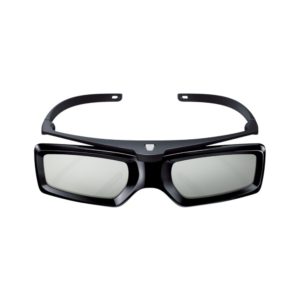
We’ll start off our list with a pair of active 3D glasses. These glasses are manufactured by Sony and are only compatible with Sony KDL-55W900A 3D television sets. The KDL offers some of the best colors available on an LCD panel. Deep black levels with excellent shadow details and gamma. The design of the TV is very sleek and the sound quality is a good as a flat screen TV can deliver.
But what about the 3D glasses? Well, the TDG-BT500A 3D glasses are as sleek as the TV they’re intended to be used with. They are made out of hard plastic and feature a futuristic design, with the lenses and the frame being partly detached from the arms and the sensor. They are unfortunately a bit heavy, which means you will feel fatigue after some time spent viewing your favorite 3D titles.
These 3D eyeglasses pair with the Sony TV quite easily. All you have to do is hold the button located on the top of the 3D glasses for about two seconds, and you’ll see the notification on the TV that it’s paired with them. The TDG’s have a LED light indicator that will blink yellow if they’re not paired with the TV, and green if they are synced. Not much to say about that.
We decided to test them out by watching Avatar in 3D. As soon as we put on the glasses we noticed their main issue. The issue is that they’re not that bright, and the TV doesn’t offer too much brightness either. We tried upping the brightness setting, but that didn’t help too much either, the images still appeared dull and murky. Thankfully, we didn’t notice to much flickering, so that’s a plus. Another issue we have with them is that they don’t offer too much room to be worn in combination with prescription glasses.
Pros
- Sleek design
- Fairly long battery life
Cons
- Not very sturdy
- They’re heavy which will cause fatigue
- They’re quite expensive
Bottom Line
Even though the Sony KDL-55W900A is an excellent tv set. The glasses it comes with could be better. However, they get the job done and you won’t experience any issues using them when watching a 3D title in a dark room.
2. Samsung SSG-5150GB
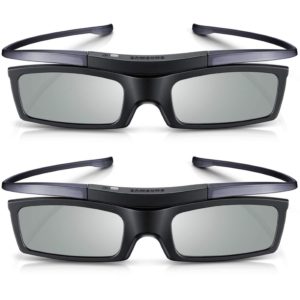
The Samsung SSG-5150GB Active Shutter 3D glasses are the third generation of 3D glasses developed by this company. They are compatible with all 2011, 2012 and 2013 Samsung D, E, ES and F series of 3D television sets.
Out of the box, these active 3D glasses come disassembled. Along with the glasses you also get two CR-1620 batteries, a very useful cleaning cloth and a short manual. We have to point out that Samsung listed that these 3D glasses use the batteries previous generation used, but that’s not the case. So if you want to get a replacement battery you better hold on to the packaging, otherwise you might purchase a wrong set of batteries.
The assembly of the eyeglasses is dead simple. All you have to do is snap the arms in their indicated places and put in the battery. The battery bay is clearly indicated by a small cap that can be opened with a coin or with the battery itself. Syncing them up with the TV is also very simple. All you have to do is start the movie on your TV and hold down the button located on the bridge of the eyeglasses until a LED indicator turns green.
When it comes to the ergonomics, the Samsung SSG-5150GBs are one of the most comfortable 3D eyeglasses we ever had a pleasure of using. They are extremely light, with the heaviest part of them being the battery. They are so light that you’ll barely notice you’re wearing them, which means you won’t get fatigued when wearing them for an extended period of time. They leave a lot of headspace for users that wear prescription glasses. However, there is a drawback to this because they don’t cover your peripheral vision. Some people might have an issue with this, but we personally didn’t because we were too immersed into the movie. They are also quite durable, so you don’t have to worry about breaking them if you drop them.
When it comes to the image quality, these 3D glasses are as good as they get. They offer the same image quality as 3D glasses that are even three times more expensive. We tested them out with by watching the Hobbit in 3D. There was no noticeable flickering, and there was almost no crosstalk which we can’t say for some of the more expensive models we came across.
Pros
- Amazing Image quality
- Very comfortable
- Excellent battery life
Cons
- The arms don’t fold, they can only be detached.
Bottom Line
If you own a Samsung 3D TV, these are the 3D glasses to go for. They offer superb image quality, and most importantly, they’re very comfortable to wear. They can last up to 160 hours on standby mode, and are incredibly durable.
3. Nvidia Vision 2
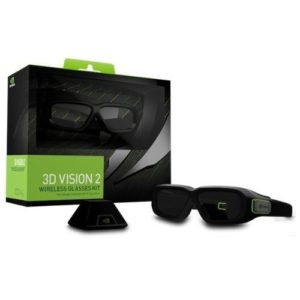
Nvidia’s 3D Vision Wireless Glasses are designed to work with its new LightBoost technology and cut out the annoying light coming from your peripheral vision.
Other than their size, the Nvidia Vision 2 3D glasses are almost identical to the original 3D Vision glasses, which means they’re still uncomfortable to wear. Samsung’s SSG-5150GB’s 3D glasses are the most comfortable ones we ever perched on our conks, and Nvidia lags well behind in the department. This is very odd because guys at Nvidia have obviously redesigned these 3D glasses with comfort in mind, but they still don’t sit naturally on the face.
Now that we have the stuff we don’t like about these glasses out of the way, let’s talk about stuff we do like about them. First thing are the lenses. The lenses on these 3D glasses feature a wraparound design, which greatly improves the viewing experience.
Having your brain decode stereoscopic 3D images while also having to deal with real life 3D in your peripheral vision is quite tiring, and we suspects it’s also closely linked to those inevitable headaches following a long viewing session. Increasing the lens size is such a simple solution to this common problem,that we’re left to wonder why it took Nvidia this long to get it sorted out. We suppose that’s the way with “exotic” technologies.
The best thing the Vision 2 3D glasses deliver is Nvidia’s new 3D tech, the LightBoost. So what is this incredible tech? We’re glad you asked! This is Nvidia’s big idea for improving 3D image quality. LightBoost is essentially an extra layer to the panel that compensates for any dimness before the image, making it twice as bright as previous 3D screens. This means that dim vision is a thing of the past!
Pros
- LightBoost technology ensures that dim images are a thing of the past!
- They are quite durable.
- Quality assembly
Cons
- They are quite heavy which means you will feel fatigue during long viewings.
Bottom Line
The Nvidia Vision 2 glasses are marketed as being LightBoost compatible, but this is also true for the older 3D Vision 1 model. They’re both active shutter 3D glasses, after all. The combination of these glasses with a LightBoost PC monitor will give you the first genuinely enjoyable 3D gaming and viewing experience.
4. Boblov JX-30 DLP Link 3D Glasses
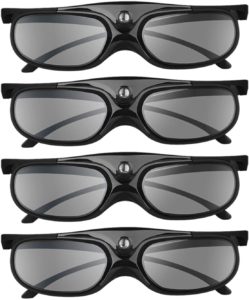
These 3D glasses are compatible with all kinds of DLP projector. It’s also compatible with products such as Samsung, Optoma, BenQ, Dell, Acer, Vivitek, NEC, and Sharp. The effective 3D glasses make use of a “DLP link” to quickly sync with DLP projectors.
These 3D glasses are not compatible with every television. It is also not compatible with Bluetooth projectors such as Epson and Sony. This product has a super-fast refresh rate of about 144Hz. The images do not flicker when using the glasses. It provides a great 3D experience.
One of the main features of these 3D glasses is that you can control the 3D effect with just one single click. If you have these glasses on and it happens you’re not experiencing the effects of 3D, all you need to do is to click on the power button to synchronize the right and left eye views. You don’t have to operate the projector.
The 3D glasses also come with a built rechargeable battery. When fully charged, it has up to 45 hours of work time. It has a standby time of 180 days. After 5 minutes of none active use, the 3D glasses would automatically be deactivated.
The Boblov DLP link 3D glasses can comfortably be worn over your regular glasses. It can be worn for an extended period because of its low weight. The glasses also come with a micro USB cable for charging, a storage pouch, a cleaning cloth, zippered glasses, and a manual.
Pros
- Quick compatibility with DLP-Link projector: The eyeglasses can easily sync with any DLP-enabled projector.
- Long-lasting battery: It has a work time of 45 hours when fully charged; Standby time of 180 days.
- Lightweight and comfortable: It can be worn over your regular glasses.
Cons
- Limited range of gadgets compatibility
Bottom Line
These 3D glasses are one of the best in the tech market. They offer an enormous value for its price. The battery capacity is impressive, you don’t have to keep charging always. The fact you can wear it over your regular eyeglasses makes it amazing. We carefully read all the reviews and concluded that it’s a product worth having.
Active VS Passive 3D Television
Are you still on the fence on which 3D tech is the best choice for you? Don’t worry, this part of the post summarizes the various pros and cons of the active and passive 3D technologies. Before we jump into the meat of the matter, we have to remind you that 3D viewing experience can be quite subjective, and it’s really up to you to draw the final conclusion on which technology works best for you.
Passive 3D Tech
Passive 3D TV sets blend two frames into one, alternating between horizontal lines for the left eye and the ones for the right eye. Passive 3D glasses have different polarization on each lens that first with their respective lines. Right lens is polarized to let through the light for even lines, while the left lens is polarized to let through the light from even lines.
Passive 3D glasses are cheaper and more comfortable from their active counterparts. However, they offer only half the vertical resolution (1929×540) because of the way they work.
3D Crosstalk
When we look at an object in real life, we see it in three dimensions because each eye sees it from a different perspective. The 6 centimeters between our eyes is more than enough to create two different images, and the difference between those images allows us to see in three dimensions. This is the principal on which both active and passive 3D TVs work.
Now let’s talk crosstalk. 3D crosstalk, commonly known as ghosting, looks like two superimposed images. It will make a section of the picture blurry, usually on the edges of an object. The best way to see what crosstalk looks like I to remove 3D glasses in a theater. This is, of course, the extreme case, where the entire image has crosstalk. However, with 3D TVs, only small parts of the image will show this effect.
There are two main reasons to why you may experience 3D crosstalk. First reason is that some TVs don’t do too good of a job displaying the correct picture to the each eye. For example, on an active 3D television, if the glasses are not in sync with the television, one eye can start to see the part of the image meant for the other eye. This is due to the TV’s response time. As the shutter hides the left eye, some 3D television may take long enough to display the next image with a faint trail of the previous one which results in an undesirable doubling effect.
In the past some theaters that utilized passive 3D made viewers suffer from even worse crosstalk than other ones. Polarization used at that time would have caused a dramatic effect if the viewer tilted their head. Thankfully, since then, the polarized lenses have seen much improvement ensuring passive 3D televisions are free of this issue.
Second reason why you might experience 3D crosstalk is the actual media you’re viewing. Some movies might have embedded crosstalk issues. Even if each eye perceives the correct picture, the movie itself can have crosstalk issues. This is mostly the case with low budget movies that were originally shot in 2D, but got a 3D remaster.
From this, it is safe to conclude that passive 3D televisions are better than active 3D televisions as far as crosstalk is concerned.
Resolution
Active 3D TVs offer full vertical resolution while passive 3D TVs offer half the vertical resolution because the image is split between the right and left eye.
The two different technologies make different uses of the resolution. Active 3D, because it alternates between two complete pictures for each eye, doesn’t affect the resolution of the content. Passive 3D, like we mentioned before, splits the vertical resolution between two frames, effectively halving it down.
This seems like a pretty dramatic difference, but in reality, the resolution is not completely halved. Some parts of the picture is shared between the two eyes, and your brain’s visual center does an excellent job at blending the information it receives. This isn’t perfect, but if you sit slightly further that’s it’s recommended, the image resolution is close to imperceptible.
Unless you’re planning on getting a full HD TV, then the difference is even smaller with 4k TVs. Because 4K TVs have twice the vertical lines, it means that the reduced vertical resolution is far less perceivable, especially because they match the source resolution.
From this we can conclude that active 3D TVs are a clear winner resolution-wise. Active 3D technically offers a better resolution, however the difference between the two 3D technologies is close to imperceptible unless you’re sitting right in front the screen. This difference gets even smaller on a 4K TV since the lines are half the size.
Image Brightness
When you put on the 3D glasses, the first thing you notice is that the brightness of the screen has been reduced about half. With both technologies (active and passive 3D), only half the light gets to the eye. With an active 3D TV, the lenses of the 3D glasses are black half of the time. With a passive 3D TV and glasses, one line out of two is black. To compensate for this issue, most TVs will automatically increase the brightness setting when displaying 3D content.
This means that both active and passive deliver the same amount of light to your eyes. Making them equally dim.
Motion
The biggest difference when it comes to motion between active and passive 3D technologies used for TVs is that active 3D shows left / right frames in sequence, while passive 3D system shows frames simultaneously. This causes an issue when there is movement on the screen.
For instance, when you follow a moving object from left to right, your eyes will be in continuous motion. Since the left / right frames are shown one after the other, your brain expects there to be a very slight difference imposition between them. Because there is none, your brain perceives it as a difference in perspective or depth instead of movement. This significantly reduces the quality of the 3D effect and can even introduce eye fatigue.
When it comes to perceiving movement in 3D, the passive 3D glasses take the cake.
Comfort
Flickering, depending on the frequency, is a common cause of discomfort with television sets. For most people, it takes as little as 30 minutes to start getting a headache from watching a flickering screen. While this can be a serious issue regardless of the TV’s support of 3D technology, models that use active 3D shutter glasses will inevitably cause this.
Because 3D glasses block every other frame, a flickering effect will always be apparent, even with models that are normally flicker free. It is a bit worse on some TVs, but it’s impossible to avoid unless you opt for a TV that supports passive 3D technology.
Passive glasses also do not require batteries in order to work. This isn’t the biggest issue, but it generally means they are more comfortable to wear than the heavier active shutter variant.
From this we can conclude that passive 3D glasses take the win when it comes to comfort.
Glasses
Unfortunately, technology has not yet advanced to the point of providing a good 3D experience without using glasses. The two 3D technologies used in televisions use totally different types of glasses. Active shutter 3D glasses, as their name suggests, utilize shuttering lenses that block the frames intermittently. When the frame meant for the left eye appears on the screen, the glasses block the right eye and vice versa. This is done so quickly that your eyes perceive the effect as a continuous feed to both eyes and trick your brain into perceiving the 2D flat image as a 3D object.
Passive 3D glasses are much simpler contraptions. The television set itself has a 3D filter that polarizes even lines for the left eye and odd lines for the right eye. The 3D glasses themselves feature a fitting polarization on their left and right lens, so the left eye only sees the even lines, and the right eye only sees the odd lines. Unlike active glasses, passive 3D glasses don’t require any synchronization with the movie that’s running on the screen. Because nothing special is being done other than different pieces of plastic or glass, they don’t require batteries either, making them much easier to maintain and they’re very light. Because of their complexity, active glasses are commonly several times more expensive.
While theaters don’t generally use a completely passive system, the gasses used are interchangeable with what is found in passive 3D television sets. Because theaters project the image on a screen instead of having the screen itself display it, it’s impossible to have different polarization for alternating lines without utilizing two different projectors. This is very rare, so theaters use a combination of the principles by showing alternating left / right frames one after the other, but with different polarization similar to passive television sets. This allows theaters to keep costs low by using a single projector and a metric ton of inexpensive passive 3D glasses. This also means that a good passive 3D television set will provide a better 3D effect than your average 3D theater.
Conclusion
Even if passive 3D television sets feature half the vertical resolution, it’s a minimal difference perceptually. Passive 3D televisions offer a better 3D experience than their active shutter counterparts. They also produce less 3D crosstalk, have no flickering, and their motion provides a better perception of depth. As a bonus, their 3D glasses are cheaper, lighter, require no power to work, and don’t require to be synchronized to the TV screen . If the only factor that’s stopping you from choosing between two 3D technologies you are better off picking a passive 3D TV and glasses.
How We Choose These Products
When compiling the list of the best 3D glasses, we were focusing on two things. Those being the ergonomics and the quality of the image.
Other things we were focusing on is the price. So we were looking for 3D glasses that offer the best bang for the buck.
So, what do you think about the 3D technology? Will it make a big comeback, or is it going to remain in the shadow of the emerging VR technology? Let us know in the comments below!
